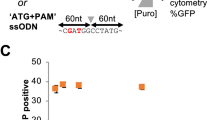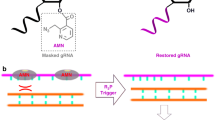Abstract
Clusters of regularly interspaced short palindromic repeats (CRISPR)/Cas systems have a powerful ability to edit DNA and RNA targets. However, the need for a specific recognition site, protospacer adjacent motif (PAM), of the CRISPR/Cas system limits its application in gene editing. Some Argonaute (Ago) proteins have endonuclease functions under the guidance of 5′ phosphorylated or hydroxylated guide DNA (gDNA). The NgAgo protein might perform RNA gene editing at 37 °C, suggesting its application in mammalian cells; however, its mechanisms are unclear. In the present study, the target of NgAgo in RNA was confirmed in vitro and in vivo. Then, an in vitro RNA cleavage system was designed and the cleavage site was verified by sequencing. Furthermore, NgAgo and gDNA were transfected into cells to cleave an intracellular target sequence. We demonstrated targeted degradation of GFP, HCV, and AKR1B10 RNAs in a gDNA-dependent manner by NgAgo both in vitro and in vivo, but no effect on DNA was observed. Sequencing demonstrated that the cleavage sites are located at the 3′ of the target RNA which is recognized by 5′ sequence of the gDNA. These results confirmed that NgAgo–gDNA cleaves RNA not DNA. We observed that the cleavage site is located at the 3′ of the target RNA, which is a new finding that has not been reported in the past.




Similar content being viewed by others
References
Doetschman, T., & Georgieva, T. (2017). Gene editing with CRISPR/Cas9 RNA-directed nuclease. Circulation Research, 120, 876–894.
Shalem, O., Sanjana, N. E., Hartenian, E., Shi, X., Scott, D. A., et al. (2014). Genome-scale CRISPR-Cas9 knockout screening in human cells. Science, 343, 84.
Doench, J. G., Nicolo, F., Meagan, S., Mudra, H., Vaimberg, E. W., et al. (2016). Optimized sgRNA design to maximize activity and minimize off-target effects of CRISPR-Cas9. Nature Biotechnology, 34, 184–191.
Bin Moon, S., Lee, J. M., Kang, J. G., Lee, N. E., Ha, D. I., et al. (2018). Highly efficient genome editing by CRISPR-Cpf1 using CRISPR RNA with a uridinylate-rich 3’-overhang. Nature Communications, 9, 3651.
Granadosriveron, J. T., & Aquinojarquin, G. (2018). CRISPR-Cas13 precision transcriptome engineering in cancer. Cancer Research, 78, 4107–4113.
Swarts, D. C., Jore, M. M., Westra, E. R., Zhu, Y., Janssen, J. H., et al. (2014). DNA-guided DNA interference by a prokaryotic Argonaute. Nature, 507, 258–261.
Swarts, D. C., Hegge, J. W., Hinojo, I., Shiimori, M., Ellis, M. A., et al. (2015). Argonaute of the archaeon Pyrococcus furiosus is a DNA-guided nuclease that targets cognate DNA. Nucleic Acids Research, 43, 5120–5129.
Ryazansky, S., Kulbachinskiy, A., & Aravin, A. A. (2018). The expanded universe of prokaryotic argonaute proteins. MBio, 9, e01935-e2018.
Wilson, R. C., & Doudna, J. A. (2013). Molecular mechanisms of RNA interference. Annual Review of Biophysics, 42, 217–239.
Kobayashi, H., & Tomari, Y. (2016). RISC assembly: Coordination between small RNAs and Argonaute proteins. Biochimica et Biophysica Acta, 1859, 71–81.
Meister, G. (2013). Argonaute proteins: Functional insights and emerging roles. Nature Reviews Genetics, 14, 447–459.
Burgess, S., Cheng, L., Gu, F., Huang, J., Huang, Z., et al. (2016). Questions about NgAgo. Protein & Cell, 7, 913–915.
Cai, M., Si, Y., Zhang, J., Tian, Z., & Du, S. (2018). Zebrafish embryonic slow muscle is a rapid system for genetic analysis of sarcomere organization by CRISPR/Cas9, but not NgAgo. Marine Biotechnology (New York, N.Y.), 20, 168–181.
Javidi-Parsijani, P., Niu, G., Davis, M., Lu, P., Atala, A., et al. (2017). No evidence of genome editing activity from Natronobacterium gregoryi Argonaute (NgAgo) in human cells. PLoS ONE, 12, e0177444.
Khin, N. C., Lowe, J. L., Jensen, L. M., & Burgio, G. (2017). No evidence for genome editing in mouse zygotes and HEK293T human cell line using the DNA-guided Natronobacterium gregoryi Argonaute (NgAgo). PLoS ONE, 12, e0178768.
Lee, S. H., Turchiano, G., Ata, H., Nowsheen, S., Romito, M., et al. (2016). Failure to detect DNA-guided genome editing using Natronobacterium gregoryi Argonaute. Nature Biotechnology, 35, 17–18.
Qi, J., Dong, Z., Shi, Y., Wang, X., Qin, Y., et al. (2016). NgAgo-based fabp11a gene knockdown causes eye developmental defects in zebrafish. Cell Research, 26, 1349–1352.
Wu, Z., Tan, S., Xu, L., Gao, L., Zhu, H., et al. (2017). NgAgo-gDNA system efficiently suppresses hepatitis B virus replication through accelerating decay of pregenomic RNA. Antiviral Research, 145, 20–23.
Ye, S., Taegeun, B., Kyoungmi, K., Omer, H., Hwan, L. S., et al. (2017). DNA-dependent RNA cleavage by the Natronobacterium gregoryi Argonaute. BioRxiv. https://doi.org/10.1101/101923
Li, J., Guo, Y., Duan, L., Hu, X., Zhang, X., et al. (2017). AKR1B10 promotes breast cancer cell migration and invasion via activation of ERK signaling. Oncotarget, 8, 33694–33703.
Wang, Q., He, R., Tan, T., Li, J., Hu, Z., et al. (2019). A novel long non-coding RNA-KAT7 is low expressed in colorectal cancer and acts as a tumor suppressor. Cancer Cell International, 19, 40.
Hu, Z., Shi, Z., Guo, X., Jiang, B., Wang, G., et al. (2018). Ligase IV inhibitor SCR7 enhances gene editing directed by CRISPR-Cas9 and ssODN in human cancer cells. Cell & Bioscience, 8, 12.
Lao, Y. H., Li, M., Gao, M. A., Shao, D., Chi, C. W., et al. (2018). HPV oncogene manipulation using nonvirally delivered CRISPR/Cas9 or Natronobacterium gregoryi Argonaute. Advanced Science (Weinh), 5, 1700540.
Acknowledgements
The authors are very grateful to Mr. Zhang Jian in the Translational Medicine Institute of the First People’s Hospital of Chen Zhou for his kind help with the GFP-positive cell analysis by flow cytometry.
Funding
This work was funded by the Hunan Province Science Fund for Distinguished Young Scholars (2018JJ1021), the Natural Science Foundation of Hunan Province (2017JJ2004), the Hunan Province Technological Innovation Guiding Plan, Clinical Medical Technology Innovation Guidance Project (2017SK51101), the Health Department project of the Hunan Province (B2017182, B20180378, B20180266, and C20180166), the Science and Technique Foundation of Chenzhou (jsyf2017021, jsyf2017023, and zdyf201838), the Key Projects of Chenzhou Science and Technology Foundation (zdyf2020008 and zdyf2020011), and the Project of Xiangnan University of 2017 to ZH.
Author information
Authors and Affiliations
Contributions
ZH, KL, and DXL conceived the study; JYQ, YLX, ZYG, XTL, JJ, TC, and ZH conducted the experiments; ZH, KL, and DXL analyzed the data; JYQ, YLX, and ZH wrote the paper; JYQ and ZH revised the manuscript. All authors read and approved the final manuscript.
Corresponding authors
Ethics declarations
Conflict of interest
The authors declare that they have no competing interests.
Additional information
Publisher's Note
Springer Nature remains neutral with regard to jurisdictional claims in published maps and institutional affiliations.
Supplementary Information
Below is the link to the electronic supplementary material.
Rights and permissions
About this article
Cite this article
Qu, J., Xie, Y., Guo, Z. et al. Identification of a Novel Cleavage Site and Confirmation of the Effectiveness of NgAgo Gene Editing on RNA Targets. Mol Biotechnol 63, 1183–1191 (2021). https://doi.org/10.1007/s12033-021-00372-1
Received:
Accepted:
Published:
Issue Date:
DOI: https://doi.org/10.1007/s12033-021-00372-1




